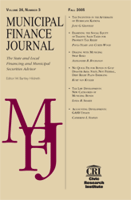Can Public Pensions Fulfill Their Promises? An Examination of Pennsylvania’s Two Largest Public Pensions
Author: Erick M. Elder.; Gary A. Wagner.
Source: Volume 37, Number 03, Fall 2016 , pp.1-22(22)

next article > |return to table of contents
Abstract:
Despite having assets of more than $75 billion, Pennsylvania’s two largest public pension plans may be underfunded by as much as $100 billion. In fact, based on their current funding ratios and an assumed distribution of asset returns, there is a 100% probability that both plans have sufficient assets to pay benefits without any increase in contributions for only the next five years. After five years, the probability declines; by 2030, the likelihood that both plans will be able to meet their promised obligations falls to 31% in the public schools plan (PSERS) and to just 16% in the state employees’ plan (SERS). While recent reforms may enhance funding ratios, even a “fully funded” plan has roughly only a 50/50 chance of being able to meet its obligations (without future increases in contributions designed to help fund already accrued liabilities) due to the volatility in the plan’s investment portfolios. Furthermore, depending on the system reforms, it is also shown that the plans could accumulate too many assets, which could lead to pressure to increase benefits and further compound the problem.Keywords: Public-sector pensions, defined benefit, investment return risk, public finance
Affiliations:
1: University of Arkansas-Little Rock; 2: Federal Reserve Bank of Philadelphia.